- In this blog post, we’ll explore why process art matters, what it looks like and how it can transform your child’s creative experience. I’ll also share practical tips for incorporating process art into your home, even if you think you aren’t naturally creative.
By the end of this read, you’ll understand the profound impact process art can have on raising creative kids.
Table of Contents
- What is Process Art?
- Process vs Product in Art
- Why Does Process Art Matter?
- How do we encourage process art at home?
- Common questions about process art – (including mess management strategies)
What is Process Art?
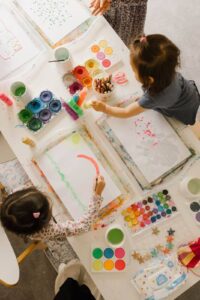
Process art is engaging and exploring with art for the creative process and the joy of creating rather than getting an end product. Unlike traditional art projects where the goal is to create a perfect frame-worthy masterpiece, process art emphasizes exploration, experimentation, and expression. Children are encouraged to use various materials and techniques to create their own unique works without any set expectations or guidelines.
Art is a process, not a product – Maryann F. Kohl
Process vs Product in Art
What are the differences between process-focused art versus product-focused art? Are both good and necessary for our children? Is one better than the other?
The product vs process art debate has been around for a long time and the truth is- there is value in both.
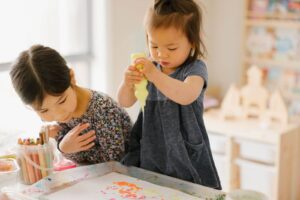
Process art centres around the creative experience. It is usually –
- Self-directed by the child with little to no direction
- Allows the freedom for self-discovery and creativity
- No expectation for the end result
- Very relaxed and free of pressure
Product art on the other hand centres around skill development. As such, it often involves –
- Adults giving directions/ setting expectations
- Clear step-by-step instructions to be followed
- A clear vision in mind for the end result
- Little to no room for creativity
Whilst product-focused art centres around skill development, it can oftentimes lead to pressure and comparison, stifling creativity and self-expression. Process art however encourages children to enjoy the act of creating and to feel proud of their efforts, no matter what the final piece looks like. So, while both types of art have their place, focusing on the process can really help children grow, be creative, and feel happy.
Why Does Process Art Matter?
Before we dive in, I’m going to share the story that changed how I see art – and why process art matters in our home.
Why Art Felt Scary (My Childhood Story)
As a child, I used to both hate and fear art (though honestly, it was more fear than hate). I would freeze and have a small panic attack looking at a blank piece of paper 😣 In school, I was often graded poorly in art, which honestly makes no sense at all since art is subjective. Friends and family would look at my pictures and tell me they looked nothing like what they were supposed to be –
“Dog?! It looks more like a mouse”, “Chicken? That’s the funniest chicken I’ve ever seen” they’d laugh kindly. I’d laugh along with them, and brush aside all the hurt that came along with it. So yes, art brought up lots of feelings for me, hate, fear, but mostly a deep sense of shame and not being good enough.
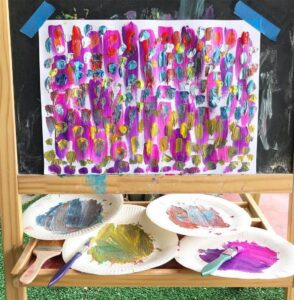
As a result of that, I never saw myself as creative and steered as far away as I could from “creative endeavours” as I thought I sucked at it. And that seeped into so many other aspects of my life – the unwillingness to give things a go, the fear of failure, the constant fear of judgment and what people would think. But most importantly – low self-confidence and self-esteem as I never felt that I was good at anything.
The Turning Point: Discovering Process Art
It was only years later when I was studying to become an early childhood teacher and had to take an art elective and learnt about process art that I discovered – art isn’t something you’re good or bad at. Instead, it is a means of expressing yourself, exploring and testing out ideas, working through emotions and problem-solving. This new perspective of art changed how I viewed myself and my kids – capable and creative, although the inner conversations within myself took longer to change and it’s still a work in progress.
What We Changed at Our Home (Simple Steps)
All of this led me to make a few simple shifts at home – small changes that let art happen easily and often:-
- Intentionally making time and space for art in our home
- Created a designated art space for our children
- Giving them access to art materials
- Offering them opportunities to get creative by engaging with process art

So much so, our art space has become the favourite play space in our home. My children have gained so many invaluable and wonderful skills as a result of us making them and space for art in our home, top of which is the ability to play creatively and independently. And that’s why I’m so passionate about process art and helping families especially kids enjoy creating art.
It’s not about raising the next Picasso. But I believe that through engaging with art, children become creative thinkers. By intentionally making space both literally and metaphorically in our children’s lives for more creativity, we are equipping them with lifelong skills and a creative confidence that will stay with them throughout their lives.
With that said, here are my top 5 reasons why process art matters and deserves a spot in your home too:
1. Encourages creativity and individuality
Process art gives our children the freedom to experiment and explore without adhering to a specific template or example. Through process art, they can let their imagination run free, creating anything and everything that comes to mind. They can think outside the box, and share their unique thoughts and feelings! When they aren’t confined by predetermined outcomes, they can discover their unique style and create artwork that truly reflects who they are.
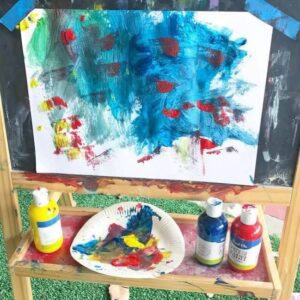
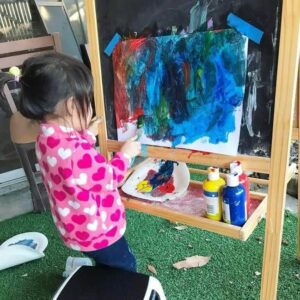
2. Supports emotional development
Process art provides children with a safe space to express their feelings, thoughts and ideas, helping them to better understand, manage and regulate their emotions.
3. Enhances problem-solving skills
Process art encourages children to engage in trial and error, fostering critical thinking and problem-solving skills. As they experiment with various materials and techniques, they will encounter unexpected challenges that require them to adapt, make decisions, and innovate, all of which are critical life skills.
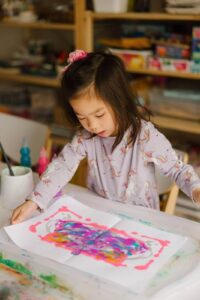
4. Builds confidence and resilience
By focusing on the process of creating rather than the end result, process art teaches children that the value lies in the act of creating. This will help them become more comfortable with taking risks and making mistakes and encourage them to keep experimenting and trying new things. They become more resilient, understanding that mistakes are part of learning and that improvement comes with practice. This mindset will help them in all aspects of life, fostering a love for learning and personal growth.
5. Developing cognitive skills

When children are engaged in process art, they develop an array of skills (often without us realizing it). For example during the scribbling stage, they are exploring creating lines, dots and various pre-writing shapes. They are also exploring how best to hold the crayons to give them the most grip and to make a stronger mark on the paper, a skill they will need for writing. For preschoolers, they might be learning about the science of colour mixing and creating their own unique colours from primary colours.
It’s easy to dismiss the little things as “oh it’s just scribbles”, or “She’s just playing”. But play is a child’s most important work and the way they learn and discover about their world and develop important life skills.
At the end of the day, a piece of paper with scribbles and lots of messy browns may or may not be trashed or recycled, and there might be nothing concrete to show for their days filled with play, but the skills and things she learns in the process belong to them forever.
How do we encourage process art at home?
Set up a home art space
The very first thing you need to do is to set up an art space. It doesn’t have to be fancy, Pinterest-like, or huge. It just needs to be comfortable, conducive, and a place where messes are welcome. Because yes, the mess is normal 🙂
Check out my dedicated home art space here 🙂
Offer a variety of art materials
Next, offer a variety of art materials as this allows children to experiment and explore different textures, colors, and techniques, sparking their creativity and imagination. I’ve written this blog about 13 mess-free art supplies that you might find helpful.
Provide ample time and opportunities to create and explore
It’s also important to provide children with ample time and opportunities to create and explore. The most aesthetic art space and quality art materials will do nothing if we don’t give them the time and encouragement they need to engage in art. Our children need us to make space in their day for creativity, to cheer them on, and to show them that we value their creative process.
For some inspiration of simple art invitations you can offer, check out these invitations to create blog posts for ideas to get you started:
7 Creative Painting Invitations for Toddlers (with minimum set-up time)
5 Creative Ways to Reuse Toddlers with Process Art
Engage in process art alongside your child
Whenever my kids are working on a piece of artwork, I love to sit beside them to engage in some creating of my own. Now, I am by no means an artist nor do I think I have artistic talent to boast of. But I want to make sure that my kids SEE me engaging in, valuing, and enjoying the creative activities myself.
Frequently asked questions about process art
1. What materials are best for process art with young children?
I personally go for safe, non-toxic, and easy-to-clean materials. Think watercolours, finger paints, and washable tempera paints for painting. Crayons, markers, and coloured pencils are great choices for drawing. Simple tools like paintbrushes, sponges, cotton swabs, playdough, clay, glue sticks, and natural items like leaves and twigs are perfect for little hands and offer endless possibilities for creativity! Looking for materials that would be suitable for toddlers? Here’s my favourite 13 mess-free art supplies.
2. How can I get my child to stop wasting art materials?
I get where this is coming from friend as I feel the same about wastage. But I’m also an educator and can see all the value of our children “wasting” materials. My greatest tip is to limit the amount of materials and variety you offer. Less is more. You don’t need an overflowing supply of art materials in order for your child to engage in process art.
3. What if my child loses interest quickly?
It can be frustrating, I know, but remember kids love exploring! Offering a variety of materials and rotating them to keep things fresh can help in keeping them interested. Start with short art sessions and gradually increase the time as their interest grows. The goal is to make it enjoyable and pressure-free 🙂
4. How can I introduce new art techniques or materials?
Introducing new art techniques or materials can be super exciting for kids! Start by showing them how to use the new materials or techniques. Keep it simple and fun, encouraging them to explore and experiment on their own. You can begin with a small, guided project to get them comfortable, then let them create freely.
5. How do I deal with the mess?
Let’s be frank here- there will be a mess when it comes to toddlers engaging in process art. My tip is to reframe your mindset about the mess. Look beyond the mess, and see the learning and experiences your child gains when engaging in process art. One of my mantras is “Bless the mess!!” I shared my tips on managing mess during process art in this post.
A final note
Engaging in process art experiences at home is so much more than “just art”. It’s instilling in them a creative confidence that will stay with them for the rest of their lives 🙂 Just as Rome wasn’t built in one day, children need to be given countless opportunities to learn how to use materials appropriately and independently and to nurture their creativity. If we don’t give them the chance to freely explore and make messes, they won’t have the opportunity to learn.
I hope you have been inspired to give process art a go. Can’t wait to see what you’ll create!
Ps. Excited to dive into process art and want some fun and engaging process art activities to try with your child? Check out Little Art Yurt Club here 🙂
08
Aug

